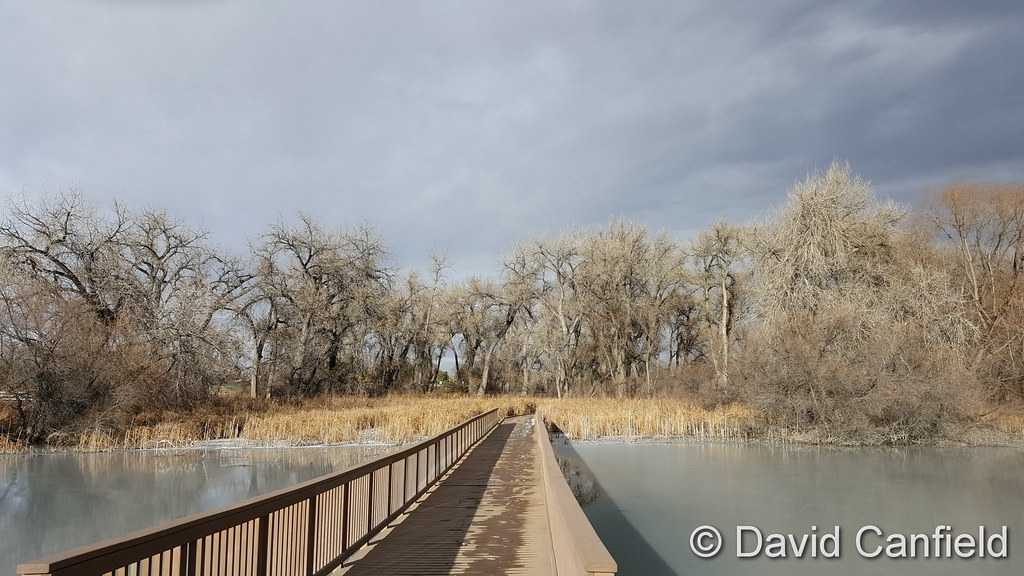For the three previous months we had seen warmer and drier than normal conditions. December finally brought an end to that streak with temperatures well below normal and precipitation almost doubt the average for the month.
The month was largely an unsettled one as a series of storm systems moved across the region. Two significant blasts of Arctic air sent the mercury plummeting. The first, from the 6th to the 8th, brought little snowfall but the second from the 16th to the 18th was quite generous. The balance of the month saw things warm up with 10 of the last 13 days seeing above normal mercury readings.
Overall, Thornton saw an average monthly temperature of 28.1 degrees. This was well below Denver’s 30 year average (1981 – 2000) for the month of December of 30.0 degrees. Out at DIA where the Mile High City’s official measurements are taken, the month averaged 27.8 degrees.
Temperatures ranged from a high of 65.7 degrees on the 30th down to a bone-chilling low of 10.7 degrees below zero on the morning of the 17th. Denver saw its warmest temperature of 65 degrees and coldest of 15 degrees below zero on the same dates.
That low reading in Denver on the 17th was also a record low for the date. Additionally, the airport saw a high temperature of only 3 degrees that day setting a new record low maximum for the 17th.
In all, Thornton saw five days where the high temperatures failed to climb above freezing and four days with temperatures below zero. Denver recorded six and four respectively.
In terms of precipitation, Denver averages 0.35 inches of liquid precipitation during December. Thornton easily bested the average with 0.64 inches for the month while Denver fared better with 0.78 inches.
Both Thornton and Denver saw above average levels of snowfall. The Mile High City averages 8.5 inches in December. In 2016, Thornton saw 8.9 inches while DIA recorded 9.7 inches.
Click here to view Thornton’s December 2016 climate report.
From the National Weather Service:
CLIMATE REPORT
NATIONAL WEATHER SERVICE DENVER/BOULDER CO
718 AM MST SUN JAN 1 2017
...................................
...THE DENVER CO CLIMATE SUMMARY FOR THE MONTH OF DECEMBER 2016...
CLIMATE NORMAL PERIOD 1981 TO 2010
CLIMATE RECORD PERIOD 1872 TO 2016
WEATHER OBSERVED NORMAL DEPART LAST YEAR`S
VALUE DATE(S) VALUE FROM VALUE DATE(S)
NORMAL
................................................................
TEMPERATURE (F)
RECORD
HIGH 79 12/05/1939
LOW -25 12/22/1990
12/24/1876
HIGHEST 65 12/30 43 22 69 12/09
LOWEST -15 12/17 17 -28 0 12/28
12/17
AVG. MAXIMUM 42.7 42.8 -0.1 40.9
AVG. MINIMUM 12.9 17.1 -4.2 17.9
MEAN 27.8 30.0 -2.2 29.4
DAYS MAX >= 90 0 0.0 0.0 0
DAYS MAX <= 32 6 5.8 0.2 10
DAYS MIN <= 32 30 29.4 0.6 28
DAYS MIN <= 0 4 2.0 2.0 2 PRECIPITATION (INCHES) RECORD MAXIMUM 5.21 1913 MINIMUM 0.00 1881 TOTALS 0.78 0.35 0.43 0.71 DAILY AVG. 0.03 0.01 0.02 0.02 DAYS >= .01 6 4.1 1.9 5
DAYS >= .10 2 1.1 0.9 3
DAYS >= .50 0 0.1 -0.1 0
DAYS >= 1.00 0 0.0 0.0 0
GREATEST
24 HR. TOTAL 0.63 12/16 TO 12/17
SNOWFALL (INCHES)
TOTALS 9.7 2016 8.5 NORMAL
RECORDS 57.4 1913
T 1905 1906 2002
DEGREE_DAYS
HEATING TOTAL 1146 1086 60 1097
SINCE 7/1 2042 2468 -426 2187
COOLING TOTAL 0 0 0 0
SINCE 1/1 878 769 109 877
FREEZE DATES
RECORD
EARLIEST 09/08/1962 10/07
LATEST 06/08/2007 05/05
...............................................................
WIND (MPH)
AVERAGE WIND SPEED 9.2
RESULTANT WIND SPEED/DIRECTION 3/167
HIGHEST WIND SPEED/DIRECTION 37/260 DATE 12/05
HIGHEST GUST SPEED/DIRECTION 46/260 DATE 12/05
SKY COVER
POSSIBLE SUNSHINE (PERCENT) MM
AVERAGE SKY COVER 0.50
NUMBER OF DAYS FAIR 7
NUMBER OF DAYS PC 18
NUMBER OF DAYS CLOUDY 6
AVERAGE RH (PERCENT) 57
WEATHER CONDITIONS. NUMBER OF DAYS WITH
THUNDERSTORM 0 MIXED PRECIP 0
HEAVY RAIN 0 RAIN 0
LIGHT RAIN 1 FREEZING RAIN 0
LT FREEZING RAIN 0 HAIL 0
HEAVY SNOW 2 SNOW 3
LIGHT SNOW 7 SLEET 0
FOG 11 FOG W/VIS <= 1/4 MILE 3
HAZE 6
- INDICATES NEGATIVE NUMBERS.
R INDICATES RECORD WAS SET OR TIED.
MM INDICATES DATA IS MISSING.
T INDICATES TRACE AMOUNT.

 As we begin the new year the winter chill begins to set in. While January can see its share of extremes, the month historically sees stable temperatures and is usually relatively dry.
As we begin the new year the winter chill begins to set in. While January can see its share of extremes, the month historically sees stable temperatures and is usually relatively dry.




